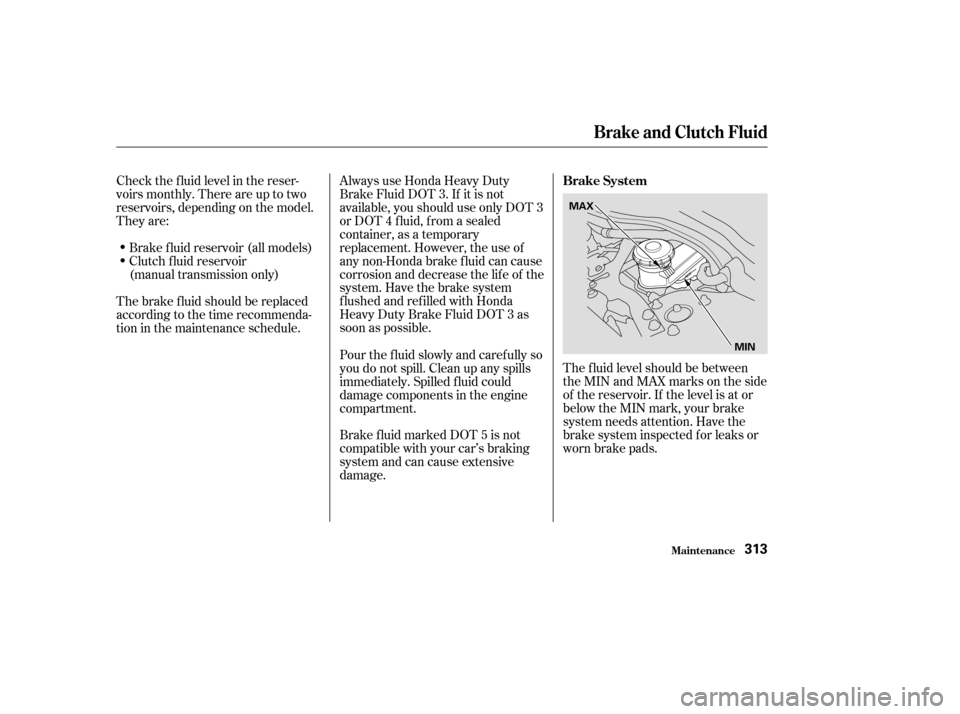Page 315 of 429
Pour the f luid to the f iller hole slowly
and caref ully so you do not spill.
Clean up any spills immediately.
Spilled f luid could damage
components in the engine
compartment.
If Honda MTF is not available, you
may use an SAE 10W-30 or 10W-40
viscosity motor oil with the API
Certif ication seal that says ‘‘FOR
GASOLINE ENGINES’’ as a
temporary replacement. However,
motor oil does not contain the proper
additives, and continued use can
cause stiffer shifting. Replace as
soon as it is convenient.The transmission should be drained
and ref illed with new f luid according
to the time and distance recommen-
dations in the maintenance schedule.
If you are not sure how to check and
add f luid, contact your Honda dealer.
T ransmission Fluid
Maint enance312
Page 316 of 429

The f luid level should be between
theMINandMAXmarksontheside
of the reservoir. If the level is at or
below the MIN mark, your brake
system needs attention. Have the
brake system inspected f or leaks or
worn brake pads.
Always use Honda Heavy Duty
Brake Fluid DOT 3. If it is not
available, you should use only DOT 3
or DOT 4 f luid, f rom a sealed
container, as a temporary
replacement. However, the use of
any non-Honda brake fluid can cause
corrosion and decrease the lif e of the
system. Have the brake system
f lushed and ref illed with Honda
Heavy Duty Brake Fluid DOT 3 as
soon as possible.
Check the f luid level in the reser-
voirs monthly. There are up to two
reservoirs, depending on the model.
They are:
Brake f luid reservoir (all models)
Clutch f luid reservoir
(manual transmission only)
The brake f luid should be replaced
according to the time recommenda-
tion in the maintenance schedule. Pour the f luid slowly and caref ully so
you do not spill. Clean up any spills
immediately. Spilled f luid could
damage components in the engine
compartment.
Brake f luid marked DOT 5 is not
compatible with your car’s braking
system and can cause extensive
damage.Brake System
Brake and Clutch Fluid
Maint enance313
MAX
MIN
Page 319 of 429
The air cleaner element is inside the
air cleaner housing on the driver’s
side of the engine compartment.
To replace it:Loosen the f our bolts, and remove
the air cleaner housing cover.
Remove the old air cleaner
element. Caref ully clean the inside of the
air cleaner housing with a damp
rag.
Place the new air cleaner element
in the air cleaner housing.
Reinstall the air cleaner housing
cover, and tighten the four bolts.
The air cleaner element should be
replaced according to the distance
recommendation in the maintenance
schedule.
1.3.
4.
5.
2.
Maint enance
Replacement
A ir Cleaner Element
4-cylinder Models
316
BOLTS
AIR CLEANER ELEMENT
Page 321 of 429
Clean the hood latch assembly with a
mild cleaner, then lubricate it with a
multipurpose grease. Lubricate all
the moving parts (as shown),
including the pivot. Follow the time
and distance recommendations in
the Maintenance Schedule. If you
are not sure how to clean and grease
the latch, contact your Honda dealer.Remove the f our nuts with a
wrench, then remove the coil
cover.
The spark plugs in your car are a
special iridium-tipped design f or
longer lif e. The spark plugs should
be replaced according to the distance
recommendation in the maintenance
schedule.
1.
ReplacementSpark Plugs
Hood L atch
(4-cylinder Models)
Hood L atch, Spark Plugs (4-cylinder Models)
Maint enance318
PIVOTS NUTS
COIL COVER
LATCH ASSEMBLY NUTS
Page 324 of 429
CONT INUED
Cleanoffanydirtandoilthathas
collected around the ignition coil.
Disconnect the wire connector
f rom the ignition coil by pushing
on the lock tab and pulling on the
connector. Pull on the plastic
connector, not the wires.
Loosen the two holding clips by
turning the heads one-quarter turn
counterclockwise with a f lat-tipped
screwdriver. Remove the cover on
the f ront cylinder bank by pulling
it straight up.
The spark plugs in your car are a
special iridium-tipped design f or
longer lif e. The spark plugs should
be replaced according to the distance
recommendation in the maintenance
schedule.
1.2.
3.
Spark Plugs (6-cylinder Models)
Maint enance
Replacement
321
CONNECTOR
HOLDING CLIP IGNITION COIL
Page 335 of 429
�µ�µ
An auto-tensioner adjusts the tension
of the drive belt. The pointer on the
auto-tensioner should be in the
proper range. It should be checked
accordingtothetimeanddistance
recommendations in the
maintenance schedule. Check the condition of the drive belt.
Examine the edges of the belt f or
cracks or fraying. The timing belt should normally be
replaced at the intervals shown in
the maintenance schedule.
In very high temperatures
(over 110°F, 43°C).
In very low temperatures
(under 20°F, 29°C).
Replace these belts at 60,000 miles
(U.S.) or 100,000 km (Canada) if you
regularly drive your car in one or
more of these conditions:
If the pointer is out of this range or
you see signs of wear, have the drive
belt replaced by your Honda dealer
as soon as possible.
6-cylinder models only
Timing Belt
Drive Belt
Maint enance
Drive Belt, Timing Belt
332
POINTER
Proper range
4-cylinder models 6-cylinder modelsPOINTER
Proper
range
Page 357 of 429

Block the rear wheels.
Fill the f uel tank.
Wash and dry the exterior
completely.
Cleantheinterior.Makesurethe
carpeting, floor mats, etc. are
completely dry.
If you need to park your car f or an
extended period (more than one
month), there are several things you
should do to prepare it f or storage.
Proper preparation helps prevent
deterioration and makes it easier to
get your car back on the road. If
possible, store your car indoors.
If the car is to be stored for a
longer period, it should be
supported on jackstands so the
tires are of f the ground.
Leave one window open slightly (if
the car is being stored indoors).
Disconnect the battery.
Support the f ront wiper blade
arms with a f olded towel or rag so
they do not touch the windshield.Coverthecarwitha‘‘breathable’’
cover, one made f rom a porous
material such as cotton.
Nonporous materials, such as
plastic sheeting, trap moisture,
which can damage the paint.
If possible, run the engine f or a
while periodically (pref erably once
amonth).
To minimize sticking, apply a
silicone spray lubricant to all door
and trunk seals. Also, apply a car
body wax to the painted surf aces
that mate with the door and trunk
seals.
Change the engine oil and f ilter
(see page ).
If you store your car f or 12 months
or longer, have your Honda dealer
perf orm the inspections called f or in
the 24 months maintenance schedule
(Normal Conditions) as soon as you
take it out of storage (see page ).
The replacements called f or in the
maintenance schedule are not
needed unless the car has actually
reached that time or mileage.
Leave the parking brake off. Put
the transmission in Reverse
(manual) or Park (automatic). 296
274
Maint enance
St oring Your Car
354
Page 408 of 429

�Î
�ÎThe burning of gasoline in your car’s
engine produces several byproducts.
Some of these are carbon monoxide
(CO), oxides of nitrogen (NOx) and
hydrocarbons (HC). Gasoline
evaporating from the tank also
produces hydrocarbons. Controlling
the production of NOx, CO, and HC
is important to the environment.
Under certain conditions of sunlight
and climate, NOx and HC react to
f orm photochemical ‘‘smog.’’ Carbon
monoxide does not contribute to
smog creation, but it is a poisonous
gas. The United States Clean Air Act
sets standards f or automobile
emissions. It also requires that
automobile manufacturers explain to
owners how their emissions controls
workandwhattodotomaintain
them. This section summarizes how
the emissions controls work.
Scheduled maintenance is on page
.
In Canada, Honda vehicles comply
with the Canadian emission
requirements, as specif ied in an
agreement with Environment
Canada, at the time they are
manuf actured.
Your car has a Positive Crankcase
Ventilation System. This keeps
gasses that build up in the engine’s
crankcase from going into the
atmosphere. The Positive Crankcase Ventilation valve routes them from
the crankcase back to the intake
manif old. They are then drawn into
the engine and burned.
The Onboard Ref ueling Vapor
Recovery (ORVR) system captures
the f uel vapors during ref ueling. The
vapors are adsorbed in a canister
f illed with activated carbon. While
driving, the f uel vapors are drawn
into the engine and burned of f . As gasoline evaporates in the f uel
tank, an evaporative emissions
control canister f illed with charcoal
adsorbs the vapor. It is stored in this
canister while the engine is of f . Af ter
the engine is started and warmed up,
the vapor is drawn into the engine
and burned during driving.
274
The Clean Air Act
Crankcase Emissions Control
System
Onboard Ref ueling Vapor
Recovery Evaporative Emissions Control
System
Emissions Cont rols
T echnical Inf ormation405